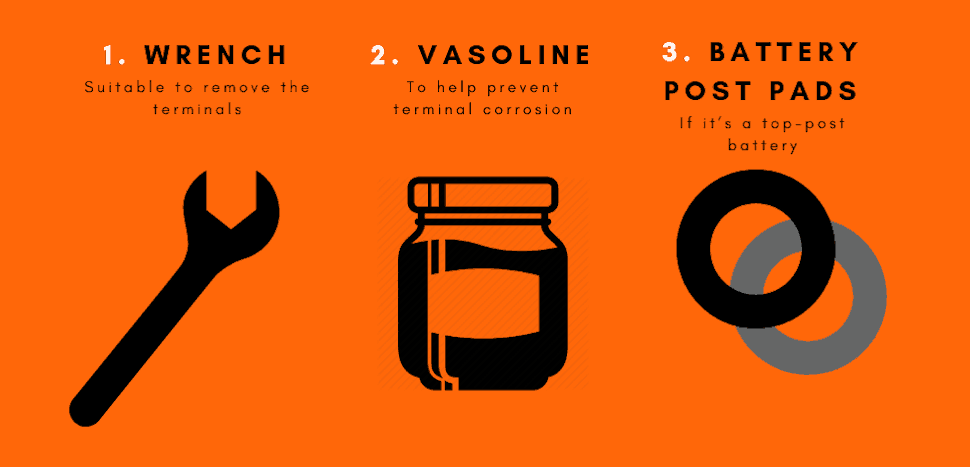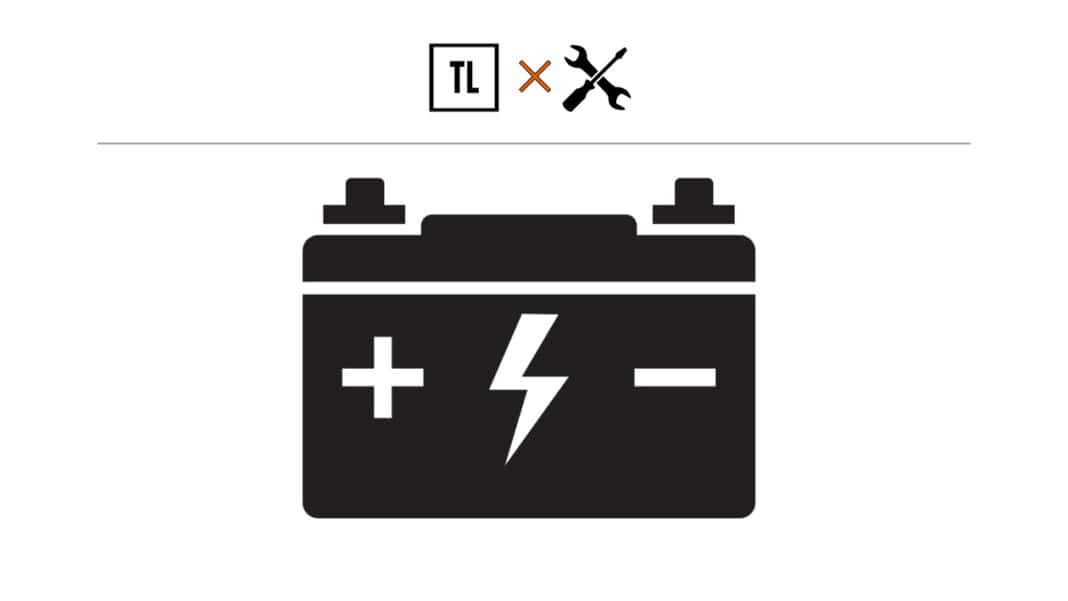1. Before You Start
Safety first
Before working on your car’s battery, remove all jewelry, and don’t wear clothing with metal zippers. Shorting out your battery with something metal will create sparks massive amounts of heat and could spark an explosion of hydrogen gases that may have formed in the area of the battery.
If that freaks you out, stop reading right now and head to your local mechanic. First step. Still here? OK, let’s begin.
What you’ll need:

- A wrench suitable to remove the terminals; a wrench, perhaps, to remove the battery hold-down posts
- A jar of petroleum jelly
- Two felt battery-post pads (if it’s a top-post battery)
And, of course, the replacement battery.
The fasteners for the battery clamps can often be prone to rounding, so try not to use an adjustable wrench. Instead, use a fixed wrench that fits well. If bolts are already rounded a bit, use locking pliers to get a firm grip.
2. Remove the Old Battery
The first thing to do, of course, is remove the faulty battery. If, at this point, you can see the negative cable — a heavy cable that runs from the battery to a point on the chassis or engine — disconnect that from the battery now. If the posts are covered, proceed to the next step, but as soon as you can see the negative post, disconnect it. Safety first.
Then, see if the battery is held down by a pair of posts, typically midway along either long side of the battery. These are typically shaped like the letter ‘J’ and are hooked at the bottom support plate and held in place by nuts at the top, holding down a strap across the battery. Some carmakers use a rubber bungee-like strap; others use a plastic shroud held down by the same kind of posts described above.
Now, disconnect the positive cable and remove the battery.
Recycle the old battery: Don’t forget to recycle the old one. Some places will accept your old battery and even provide an incentive.
3. Installing the New Battery
Inspect the old cables
Once the old battery is out, inspect the cables. If you see signs of broken strands of the wires or frayed insulation presenting the possibility of a short, replace the connector or the cable. If your cable has multiple wires, bind them together with some electrical tape just to remind you they go together.
Place the new battery in
Then, place the new battery in its place. If the posts are on the top, place the felt pads over the terminals and push them to sit on the top of the battery. Unless your tie-down device was a shroud that enclosed the terminals and the battery, replace the tie-down device now.
Clean the battery cable connectors
Clean the battery cable connectors. Your battery terminals should be shiny new, but the clamps may not be. A wire brush and, if needed, some baking soda and water solution should get them as good as new.
Connect the positive and negative terminals
Place the clamps over the post (or start to thread the bolt in side-mount batteries), beginning with the positive terminal. Start with the positive terminal so that while you’re working on it, it can’t short out to the chassis by accident since the chassis isn’t yet connected to the battery.
Then, move to the negative terminal. Here, it doesn’t matter if your tools short the terminal to the chassis since shorting it to the chassis is the entire point of installing the negative cable.
Give each terminal a covering of petroleum jelly to help prevent corrosion. If your tie-down device was a cover for everything, replace it now.
Make a note of the battery replacement date:
Finally, make a note of the date on which you changed the battery. The next time the battery fails, it will be a good indication of whether it’s an expected failure or premature and the rest of the electrical system requires attention.
How Long Do Car Batteries Last?
Estimates of battery life vary and depend on the type of battery. Batteries can last as short as six months or as long as ten years. Battery warranties also vary based on the type of battery. Some batteries are marketed with only a 3-month warranty and can go up to a four- or five-year pro-rated warranty. If your battery is out of warranty, congratulations, you’ve treated it well. But keep an eye out for the signs of its demise.
Can I buy my car battery more time?
Yes, you can, and one of the key ways to do that is also the simplest: keep the battery in a vehicle that is driven regularly. Batteries don’t react well to being allowed to discharge to 50 percent or less of capacity, and your car’s alternator is ill-equipped to deal with such a drastic discharge.
Since batteries will naturally discharge over time, a vehicle that sits for a week or more between drives will put more strain on its battery than a vehicle driven daily. If you park outside in a cold winter climate, consider using an electric battery blanket. Keeping the battery warm helps slow the natural discharge process, which speeds up in the cold. That helps to leave you both with enough cranking power to start the engine in the morning and with less overnight discharge.
This next step won’t necessarily buy your battery time, but it will help avoid a false indication your battery is dead: keep the terminals clean. The chemical process can leave acid deposits on the terminals, which can interfere with a good connection—baking soda and water work, followed by a smear of petroleum jelly.
How do I know my battery’s on borrowed time?
Suppose your car loses its typical crank-crank-ka-ching! kind of quick starts, replaced by lug-lug-lug-lug-OK-already-I’ll-start, but then runs fine once it’s started, there’s a good chance last rites are in store for your battery.
If it’s hard to start but then runs well, it is likely your battery and not your alternator since the battery is primarily there to start the car and then let the alternator take over.
Don’t be too hasty to rush off to the parts store, though. Check that the terminals are clean, and if it’s not maintenance-free and have filling caps to add water, see if the water is low. If it is, add only distilled water. If these check out, your battery is about to, as well.
What if I messed up, and my battery’s already dead?
Boosting a battery is an emergency technique and should get you back on the road immediately, but it’s not the ideal way to breathe life back into a battery. Such a deep discharge can cause your alternator to overcharge the battery, which only compounds the problem of having let it get so low in the first place.
If you can, remove the battery from the vehicle and either use a computer-controlled three-stage charger to recharge it or find a mechanic who can do this for you. This form of charging is the safest way to bring a battery up from a deep discharge. Advance auto parts locations will also recharge your battery at no cost to the customer.
What about storage?
If you plan to store a vehicle, baby your battery by removing it from the vehicle and storing it indoors attached to an intelligent battery charger. Keeping a charge in the battery and preventing it from freezing are important considerations for storage. Look for a computer-controlled charger to switch from charging to maintenance as needed.
Keep it off a concrete floor, as well: placing it on a piece of wood or some other insulator is effective.
Other car battery FAQs
Here’s how lead acid batteries work
A car battery contains six cells, each delivering 2.1 volts of electricity for 12.6 volts at full charge. Each cell has two lead plates, an anode, and a cathode, immersed in an electrolyte, which is typically sulphuric acid.
A chemical reaction between the plates and the acid deposits leads to sulfate on the surfaces of each plate, giving off free electrons — electricity — in the process.
Charging a battery is the reverse of that process: applying a reverse current to the battery terminals separates the lead sulfate from the plates, and it reforms back into sulphuric acid. A battery fails when it can no longer separate the lead sulfate from the plates and thus “Won’t hold a charge.”
What does that mean for battery life?
If you guessed that the depositing of acid onto the plates and the transfer back to the electrolyte can occur a limited number of times, you’re right. One of the key rules in physics is there can be no “perfect” machine: every system, including the chemical process inside a battery, will experience some loss.
So, a battery failure is always a question of when, not if. Also, lead sludge can form at the bottom of a cell, eventually shorting out the plates.


